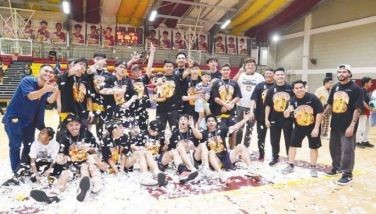San José alumni
November 14, 2005 | 12:00am
A few days from now, November 17 and 18, the alumni (both ordained and lay) of San José Seminary will be holding their 76th homecoming. (Registration begins 2:00 p.m. of the 17th.) This seems a good occasion to give a brief summary of the history of that venerable institution.
The story begins in the year 1601 when, with great pomp and ceremony, a small institution was opened called Colegio de San José. It was administered by the Jesuits but funded from an estate bequeathed by Don Esteban Rodriguez de Figueroa, who had died in battle against the Muslims of the Rio Grande de Mindanao.
The Colegio de San José was a "college" in the European sense (like the "colleges" at Oxford and Cambridge). The San José collegians lived and were formed there, but attended classes at the nearby Jesuit university, the Colegio de Manila.
The arrangement lasted 167 years until 1768 when the Jesuits were expelled by order of the King of Spain. All Jesuit assets and institutions were confiscated by the Crown, but the Colegio de San José, although under Jesuit administration, was not owned by them. It was a separate corporate entity, a Pious Corporation (obra pia). For a while the Archbishop used the building and revenues of the estate for a seminary. Then it became a school of secondary education run by secular priests. (Rizal’s brother Paciano studied there before enrolling in law at the University of Santo Tomas.)
In the 1870s the Dominicans obtained the King’s permission to take over the administration of the San José estate and use its building and revenues to maintain a school of medicine and pharmacy. (Rizal made his first three years of medical studies there.)
When the Philippines came under American sovereignty, an influential group of physicians headed by Pardo de Tavera questioned the right of the Dominicans to administer the San José Estate, since (they claimed) the "Colegio de San José", as a charitable corporation, was under the jurisdiction of the government. The case dragged for several years with some interesting developments, but was finally settled by the Supreme Court which decreed that, since it was an "obra pia" it was under the jurisdiction of the Church. A few months later, in March 1910, Pope Pius X issued a decree that the San José estate be restored to the administration of the Jesuits in accordance with the intention of the original donor, and that the revenues be used for educating students for the priesthood.
Those decisions of the Supreme Court and of the Pope were not well received in certain quarters, and there were street demonstrations denouncing – not the Supreme Court nor the Pope – but the Jesuits who had had no hand in the case.
It took five years before everything was settled and a full transfer of administration could be made. The University of Santo Tomas asked that they be allowed to keep the building and its equipment, and as that was half of the assets, and since the remaining assets in land were burdened with debts, the Jesuits begged to be excused from the administration. They were told that they could not refuse to accept a Pope’s decree.
Without a building of its own the Colegio de San José reopened in 1915 and was housed in one wing of the Jesuit buildings in Ermita, where the Observatory and the Normal School of San Javier occupied other wings. The reopened San José started on a modest scale as a minor seminary. In the 1920s, it became a major seminary as well.
In 1932 the Ateneo in Intramuros burned down, and it was decided to relocate it at Padre Faura in Ermita. San José Seminary was relocated in a building left untouched by the fire in Intramuros, the Jesuit residence attached to San Ignacio Church. There the Seminary remained until a building was erected on a newly acquired lot in Balintawak. During the Japanese Occupation the seminary moved from place to place but the seminarians were finally sent home.
At the Liberation, with the Balintawak building severely damaged, San José Seminary reopened in rented buildings in Santa Ana, Manila, until a new building was erected at Balintawak. In the 1950s the Seminary moved to larger quarters on what was then called Highway 54 (now EDSA). Finally in the 1960s the Seminary moved to the Ateneo Campus, the seminarians attending classes at the Ateneo and at the newly opened Loyola School of Theology.
All through these years, wherever the Seminary was located, the alumni returned for their yearly homecoming.
The San José alumni are many and distinguished. They include archbishops, bishops, monsignors, priests and laymen. The Archbishop of Manila and the Archbishop of Jaro (President-elect of the Philippine Bishops’ Conference) are among them. Many of these attend the yearly homecoming.
One reason why so many of them like to go back is that they look upon the Seminary as their spiritual home. They like to meet old friends, but also they hope to recapture their youthful ideals.
The story begins in the year 1601 when, with great pomp and ceremony, a small institution was opened called Colegio de San José. It was administered by the Jesuits but funded from an estate bequeathed by Don Esteban Rodriguez de Figueroa, who had died in battle against the Muslims of the Rio Grande de Mindanao.
The Colegio de San José was a "college" in the European sense (like the "colleges" at Oxford and Cambridge). The San José collegians lived and were formed there, but attended classes at the nearby Jesuit university, the Colegio de Manila.
The arrangement lasted 167 years until 1768 when the Jesuits were expelled by order of the King of Spain. All Jesuit assets and institutions were confiscated by the Crown, but the Colegio de San José, although under Jesuit administration, was not owned by them. It was a separate corporate entity, a Pious Corporation (obra pia). For a while the Archbishop used the building and revenues of the estate for a seminary. Then it became a school of secondary education run by secular priests. (Rizal’s brother Paciano studied there before enrolling in law at the University of Santo Tomas.)
In the 1870s the Dominicans obtained the King’s permission to take over the administration of the San José estate and use its building and revenues to maintain a school of medicine and pharmacy. (Rizal made his first three years of medical studies there.)
When the Philippines came under American sovereignty, an influential group of physicians headed by Pardo de Tavera questioned the right of the Dominicans to administer the San José Estate, since (they claimed) the "Colegio de San José", as a charitable corporation, was under the jurisdiction of the government. The case dragged for several years with some interesting developments, but was finally settled by the Supreme Court which decreed that, since it was an "obra pia" it was under the jurisdiction of the Church. A few months later, in March 1910, Pope Pius X issued a decree that the San José estate be restored to the administration of the Jesuits in accordance with the intention of the original donor, and that the revenues be used for educating students for the priesthood.
Those decisions of the Supreme Court and of the Pope were not well received in certain quarters, and there were street demonstrations denouncing – not the Supreme Court nor the Pope – but the Jesuits who had had no hand in the case.
It took five years before everything was settled and a full transfer of administration could be made. The University of Santo Tomas asked that they be allowed to keep the building and its equipment, and as that was half of the assets, and since the remaining assets in land were burdened with debts, the Jesuits begged to be excused from the administration. They were told that they could not refuse to accept a Pope’s decree.
Without a building of its own the Colegio de San José reopened in 1915 and was housed in one wing of the Jesuit buildings in Ermita, where the Observatory and the Normal School of San Javier occupied other wings. The reopened San José started on a modest scale as a minor seminary. In the 1920s, it became a major seminary as well.
In 1932 the Ateneo in Intramuros burned down, and it was decided to relocate it at Padre Faura in Ermita. San José Seminary was relocated in a building left untouched by the fire in Intramuros, the Jesuit residence attached to San Ignacio Church. There the Seminary remained until a building was erected on a newly acquired lot in Balintawak. During the Japanese Occupation the seminary moved from place to place but the seminarians were finally sent home.
At the Liberation, with the Balintawak building severely damaged, San José Seminary reopened in rented buildings in Santa Ana, Manila, until a new building was erected at Balintawak. In the 1950s the Seminary moved to larger quarters on what was then called Highway 54 (now EDSA). Finally in the 1960s the Seminary moved to the Ateneo Campus, the seminarians attending classes at the Ateneo and at the newly opened Loyola School of Theology.
All through these years, wherever the Seminary was located, the alumni returned for their yearly homecoming.
The San José alumni are many and distinguished. They include archbishops, bishops, monsignors, priests and laymen. The Archbishop of Manila and the Archbishop of Jaro (President-elect of the Philippine Bishops’ Conference) are among them. Many of these attend the yearly homecoming.
One reason why so many of them like to go back is that they look upon the Seminary as their spiritual home. They like to meet old friends, but also they hope to recapture their youthful ideals.
BrandSpace Articles
<
>
- Latest
- Trending
Trending
Latest
Trending
Recommended

December 26, 2024 - 12:00am


























